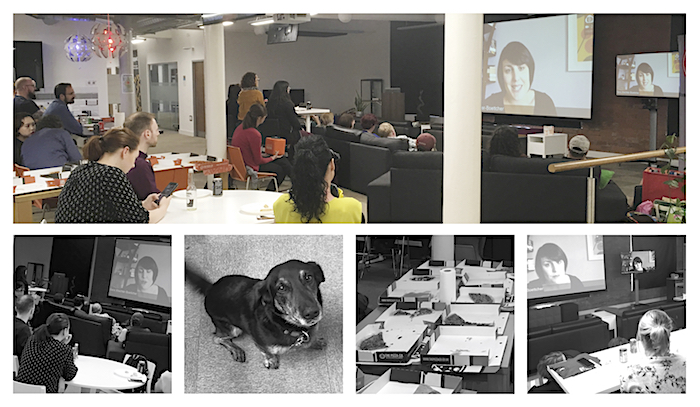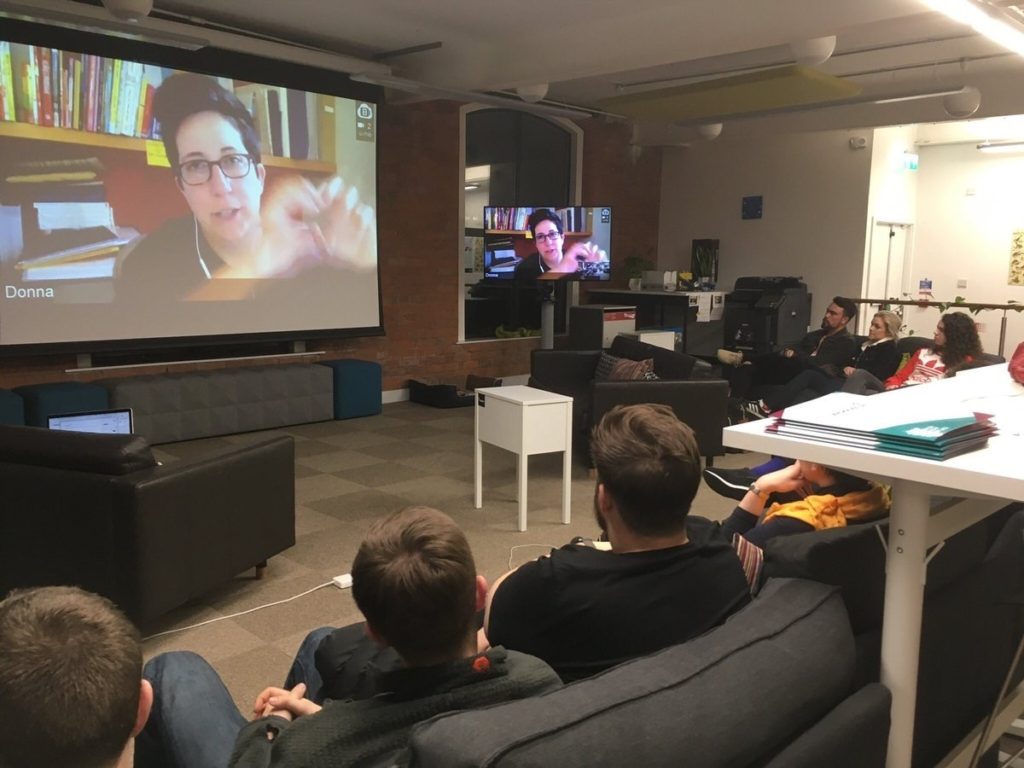The Belfast UX bookclub meetups continue, and 30 May gathering had author Sara Wachter-Boettcher taking questions and providing insights on ’Technically Wrong: Sexist Apps, Biased Algorithms, and Other Threats of Toxic Tech’.

This marked the twentieth UX Belfast meetup I’ve organised and, significantly, the best attended. A partnership with Women in Tech Belfast for the evening contributed hugely to that milestone. That said, interest in the group is rising rapidly, with over 220 members on the Meetup.com page at time of writing.
Sara’s book made Fast Company’s Top 10 Business & Leadership books of 2017, and Wired’s Top Tech books of 2017. Although a relatively short read, Sara has managed to gather a shocking number of case studies and examples where technology might be successfully delivering ‘engagement’ with users but letting humans, even society, down in the process.
Further information on the book, as well as Sara’s work as an independent content and UX consultant, can be found at her website http://www.sarawb.com.
Huge thanks to partners for the evening, Women in Tech BFS. Thanks also to PuppetBelfast for providing the great venue and refreshments, Slice app for the copious amounts of pizza and to WW Norton UK for discounts and copies of the book to give away.
To thank Sara for her time, a donation has been made to local charity, WomensTec. For more information visit http://www.womenstec.org
Psychology is just one of many areas designers can sometimes stray into for guidance or assistance. Anything which reminds us that we are flawed humans, attempting to design useful things for other humans is a good thing.
Carl Rogers’ Person-Centred Therapy (PCT) makes for interesting reading for the modern design professional. Rogers’ innovative approach, now over 50 years old, ran counter to the remote and detached forms of psychotherapy prevalent at the time. Specifically, PCT contains a number of principles that align with key qualities of effective design thinkers and problem-solvers.
The approach features three core conditions, each of them with direct relevance to the creation of positive user experiences.
One of Roger’s core conditions is unconditional positive regard (UPR). UPR is “the basic acceptance and support of a person regardless of what the person says or does”. Substitute person for user and you have a pretty good foundation for user-centred design. As design luminary Don Norman has put it, “what we call ‘human error’ is a human action that … flags a deficit in our technology. It should not be thought of as an error.” Which sounds like UPR in so many words.
Another condition is congruence; “the willingness to transparently relate to clients without hiding behind a professional or personal facade”. The parallel in design might be a desire to facilitate top tasks, and present easy paths to goals without the clutter of marketing or sales to present obstacles.
The essence of user-centred design is appreciating users as humans with needs, goals and limited time on their hands in which to achieve them. And why must we humanise the user? In order to practice the human quality of empathy – coincidentally the third of Rogers’ core conditions.
There are increasing amounts of lip service given to empathy in our professional & social feeds. It sounds worthy and is difficult to argue against. What we don’t often see are answers to questions about how to leverage it, how to make it practical.
The imperative of empathy for designers means identifying with others enough to create something which, no matter how small, makes their life easier. UPR has huge relevance; as designers we should demonstrate a positive regard for whatever our users’ motivations and needs might be. To create meaningful product experiences which connect users with their goals, it falls on us also to treat the pursuit of those goals and associated needs with respect.
Good design demands empathy and insight. UCP provides some simple ground rules for beginning to flex that empathy muscle.
This time round we had Donna Lichaw (@dlichaw) talking about her book The User’s Journey: Storymapping Products that People Love.
Donna has a background in screenwriting, and carried over the idea of mapping out story from the world of film as she transitioned into products. In the book we’re offered examples from film & TV (Back to the Future and Breaking Bad fwiw), then examples of how that transposes to design.

The storymap always follows this pattern (above), the challenge is then to populate the story with the most critical elements of the user experience. N.B. Although Campbell’s ‘Hero’s Journey’ is referenced, that isn’t the central model or focus of the book.
Examples of effective application of the technique included Donna’s own experience with FitCounter, where rate of retention during onboarding doubled, despite extending signup from 5 to 15 steps! Another example given is the signup experience of Twitter during it’s major growth period.
During Q&A Donna suggested storymapping was another tool that could work alongside more traditional methods; in practice I anticipate it will take significant buy-in from an early stage, right across the team. Potentially it might impinge or negate completely many accepted UX practices. For instance, some terms that Donna makes use of might be a formula for ambiguity in the UX vs agile conundrum, not least the definition of “stories” itself.
That said, Donna didn’t get caught up in semantics; the book is simply advocating for increased shared understanding, using story – in a holistic sense – as the agent to establish clarity for project goals. It’s a relatively short read, and makes a compelling case for storymapping to bring something fresh to product discussions. It’s but a short step away from experience mapping and traditional user stories; a consolidation of disparate elements under the banner of story.
If you have time, this is an excellent video of Donna’s presentation at Mind The Product in London, 2016.
Check the resources Donna has provided on her website.

A quick history of UX Bookclub Belfast: started around 10 years ago and hosted by an agency named Front. They were acquired by Monotype in 2012 at which point myself and few others took up as organizers, until early 2016 when it ran out of suitable venues… and interest. FF to late 2017 and we held the first rebooted bookclub (now with added Meetup.com!)
UX as a new year’s resolution
Television ads, with easy answers to any number of personal improvement and personal transformation challenges, will race to fill the vacuum left by the stores trying to convince us that they ‘do’ Christmas better than all the others. Exercise gadgets, diet plans, fitness DVDs by an endless string of B and C list celebrities will be paraded across our screens. We all know the pattern. It is recurrent, seasonal.
In boardrooms and meeting rooms across the land, similar cyclical activities may be underway: discussions centering around the need to improve performance in particular areas. Just possibly, this may involve performance online. Maybe that website that no–one believes is really pulling its weight for the organisation has had its time. Yes, that’s it, it’s time for a new website.
Fulfilling Einstein’s definition of insanity – doing the same thing over and over again and expecting a different result every time – a lack of attention to underlying challenges will result in repeated, failed attempts to meet any tangible goals. No questions are asked of the old website. No specific, relevant targets set for the new one. Clarity of purpose gets lost in interdepartmental wrangling.
In many cases, a vague sense of the website having to achieve something will exist, but what that something is will too frequently be weighted towards the organisation’s view of the world.
Increasingly, discussion of this nature will turn towards the need for a UX/UI/[insert your acronym of choice here] guru. Sometimes this will involve hiring a single individual to provide the essential missing ingredients – as evidenced recently, with a company seeking to recruit a “Creative Front–end / UI / UX Engineer”. Nothing could signal more clearly ‘we don’t know what we’re doing but we hope that by throwing some terms around something magic will happen’.
Without something changing beyond the veneer then, like the hopeless dieter who is all talk at the water cooler while gorging out on nachos and chocolate at night, very little is likely to change. Without a commitment to a customer-centred approach the new digital venture, be it an app, a website, whatever, becomes that oddest of man-made endeavours: a folly.
The lessons from recent history are clear, right across the digital industries that innovation and market advantage are gained through customer insights and user-centred action.
GOV.UK is quietly revolutionising transactional services through a commitment to understanding the needs of the user. If you have renewed your car tax online recently, you’ll perhaps know what we mean.
Umpqua Bank has gone from 6 branches in 1994 to almost 364 branches today, across 5 U.S. states, counter to conventional wisdom which says that physical branches are a thing of the past. Through deeper understanding of customer needs, Umpqua created spaces that customers actually want to visit.
Zappos built a billion dollar business by eschewing traditional media and investing instead in a superior user and customer experience, well ahead of that offered by its competitors.
These advantages require a change that is more than just a fad – or a diet if you like. It is a lifestyle change, a cultural change that requires buy-in from all levels within an organisation.
So when those familiar conversations begin again around you, ask yourself: “How are we actually going to win this time? What is going to be different this time round?”.
A Happy and Prosperous New Year to you, and whatever your New Year resolutions are, may they bring the lasting change that you aspire to.